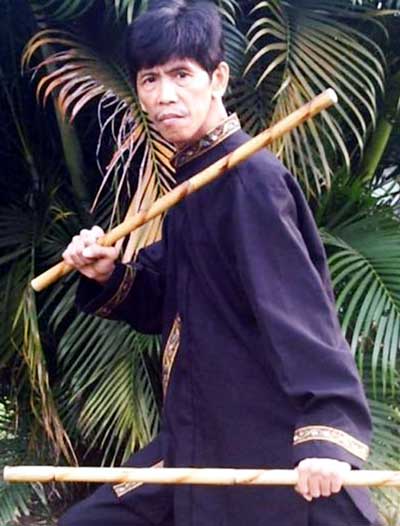 Eskrima - Philippines: meaning "skirmish" - a mostly weapons-based fighting style that combines punches, kicks, takedowns and joint lock techniques with stick and sword or knife fighting techniques. Eskrima (also known as Arnis and in the West sometimes as Kali) is the umbrella term for the traditional martial arts of the Philippines, which emphasize weapon-based fighting with sticks, knives and other bladed weapons, and various improvised weapons. It also includes hand-to-hand combat and weapon disarming techniques.
Eskrima - Philippines: meaning "skirmish" - a mostly weapons-based fighting style that combines punches, kicks, takedowns and joint lock techniques with stick and sword or knife fighting techniques. Eskrima (also known as Arnis and in the West sometimes as Kali) is the umbrella term for the traditional martial arts of the Philippines, which emphasize weapon-based fighting with sticks, knives and other bladed weapons, and various improvised weapons. It also includes hand-to-hand combat and weapon disarming techniques.
The most basic and common weapon in eskrima is the yantok. They are typically constructed from rattan, an inexpensive stem from a type of Southeast Asian vine. Hard and durable yet lightweight, it shreds only under the worst abuse and will not splinter like wood, making it a safer training tool. This aspect makes it useful in defence against blades. Kamagong (ironwood or ebony) and bahi (heart of the palm) are sometimes used after being charred and hardened. These hardwoods are generally not used for sparring, however, as they are dense enough to cause serious injury, but traditional sparring does not include weapon to body contact. The participants are skilled enough to parry and counterstrike, showing respect in not intentionally hitting the training partner. In North America and Europe, eskrima practitioners wear head and hand protection while sparring with rattan sticks, or otherwise use padded batons. Some modern schools use sticks made out of aluminium or other metals, or modern high-impact plastics.
Many Filipino systems focus on defending against and/or reacting to angles of attack rather than particular strikes. The theory behind this is that virtually all types of hand-to-hand attacks (barehanded or with a weapon) will hit or reach a combatant via these angles of attack and it is reasoned that it is more efficient to learn to defend against different angles of attack rather than learning to defend against particular styles, particular techniques or particular weapons. For instance, the technique for defending against an attack angle that comes overhead from the right is very similar whether the attacker uses barefists, a knife, a sword or a spear.
Older styles gave each angle a name, but more recent systems tend to simply number them. Many systems have twelve standard angles, though some have as few as 5, and others as many as 72. Although the exact angles, the order in which they are numbered (numerado), and the manner in which they're executed vary from system to system, most are based upon Filipino cosmology. These standard angles are used to describe exercises; to aid memorization, a standard series of strikes from these angles called an abecedario (Spanish for "alphabet") is often practiced. These are beginner strikes or the "ABC's" of eskrima.
Mano Mano is the empty-hand component of Filipino martial arts, particularly eskrima. The term translates as "hands" or "hand to hand" and comes from the Spanish word mano (hand). It is known as suntukan in Luzon and pangamot in the Visayas. American colonists referred to it as "combat judo". Mano mano includes kicking, punching, locking, throwing and dumog (grappling). Filipino martial artists regard the empty hands as another weapon and all the movements of mano mano are directly based on weapon techniques. In eskrima, weapons are seen as an extension of the body so training with weapons naturally leads to proficiency in bare-handed combat. For this reason, mano mano is generally taught in the higher levels of eskrima because advanced students are expected to be able to apply their experience with weapons to unarmed fighting.
Here are a couple of videos from YouTube to show both the sport sparring aspect on the left and the practical defense aspect on the right. The video on the right was done as a small demonstration in the streets. Please ignore the dog barking in the background because the instructors are really good.
|
Below is a video about Eskrima from The History Channel TV Series Human Weapon
|
|
Please refer to our references as we have used a few different sources for the basic explanation of each martial art discipline. Many of our direct links, images and text will be from the site Wikipedia which is not known for the most accurate information when it comes to doing a thesis or studying for ones P.H.D. but does have a large collection of data that is well organized. Much of the text regarding martial arts styles on Wikipedia seems to generally sum up each discipline as good as many other sources. We do not intend to re-invent the wheel, but we do want to roll you in a good direction in order to get a glimpse of each style.
| References: | http://www.usgyms.net | |
| http://en.wikipedia.org | ||
| http://www.thelawofthefist.com | ||

